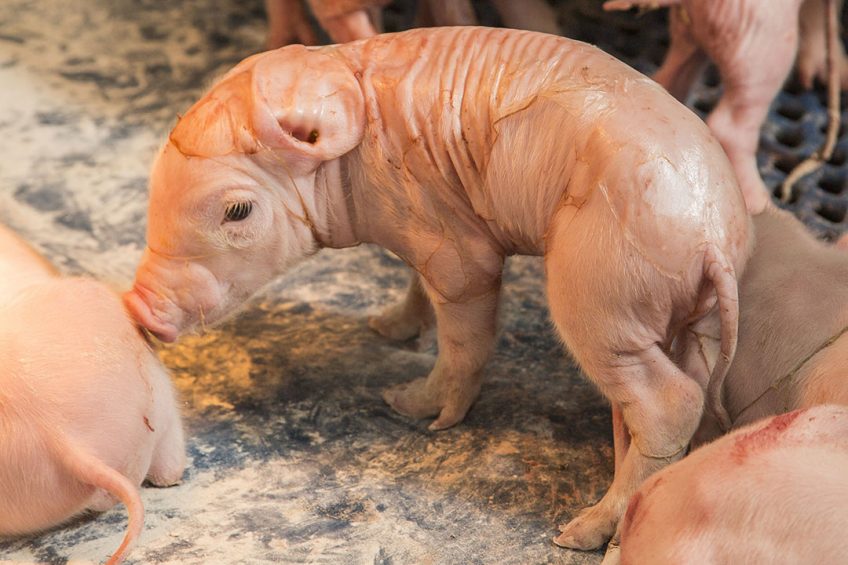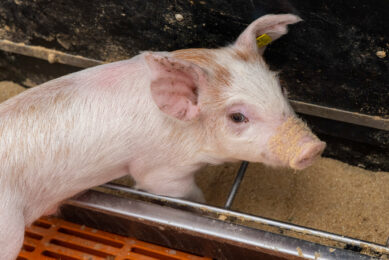Identifying ‘at risk’ piglets

There is a critical relationship between piglet birth weight and pre-weaning mortality, several studies suggest. Researchers therefore set out to identify a birth weight threshold value for pre-weaning mortality by analysing data from a combined total of 4,068 piglets from 394 litters on four commercial farms.
Improving pig survival at all stages of production has recently been identified as a swine industry priority. The US swine industry benchmark average values over a six year period (2012–2017) for pre-weaning, nursery, and finishing mortalities were 17.6%, 4.6%, and 5.3%, respectively. This corresponds to overall birth to market swine mortality rates of approximately 27.5%, with 64% of the mortality occurring prior to weaning.
Selection for litter size has enabled marked advances in sow productivity. However, as litter size increases, birth weight decreases and the number of small piglets (<1kg) increases. furthermore, the number of embryos may exceed uterine capacity, resulting in intrauterine growth restriction (iugr), which negatively affects neonatal survival. piglets with iugr are commonly referred to as ‘runts’. common measurements used to classify ‘runt’ or iugr pigs are birth weight, birth weight relative to litter average, body mass index, crown-to-rump length, and plasma insulin like growth factor 1 concentrations. pigs are at greatest risk for mortality in the first four days of life. the most common causes of death are crushing, low viability, and starvation. low birth weight and iugr negatively affect locomotor skills, vitality, ability to nurse, blood glucose, fat deposition, and thermoregulation, which place these pigs at a competitive disadvantage relative to heavier counterparts.>
The importance of birth weight
It is well known that piglet birth weight is an important metric for survival, but birth weight classifications vary greatly across studies, and a birth weight threshold for increased pre-weaning mortality has not been previously established. Therefore, an analysis was established to identify a birth weight threshold associated with increased risk for pre-weaning mortality. The aim was to allow researchers to benchmark the incidence of low birth weight piglets in commercial settings that are a target population for interventions, biological investigations, and genetic improvement programmes.
Birth weight and pre-weaning survival data of 4,068 piglets were analysed from two studies to identify a relationship between birth weight and increased pre-weaning mortality. These data sets were selected as they represented modern commercial conditions and procedures representative of the United States and Europe. The Bergstrom (2011) data set included 216 litters and 2,205 live born piglets from one farm in the United States, while the Jourquin (2015) data set consisted of 178 litters and 1,863 live born piglets from three farms in Spain. Table 1 provides additional details on the genetics, parities, and weaning ages used on each farm. According to farm standard operating procedures, male piglets on the US farm were surgically castrated within the first 7 days of life, while male piglets in Spain were not castrated.
Trial set-up and results
In both studies, the total number of piglets born alive, stillborn, and mummified were recorded for each litter. Within 24 h of farrowing, after initial colostrum consumption, each live piglet was identified with a unique ear tag and weighed using a scale with a locking digital display. Body weight was recorded to the nearest 0.1 kg. Survival status of each piglet was monitored and tracked from birth until weaning. Piglet birth weights were summarised into 18 different birth weight categories. Pre-weaning mortality was then summarised for each category and results were plotted.
The average litter size across the two data sets was 13.18, but the EU study averaged 2.12 more pigs per litter than the US study. The average birth weight across studies was 1.51 ± 0.38 kg, and there were no major differences in birth weights or birth weight percentiles between the 2 studies. The average pre-weaning mortality across the two studies was 12.2%, but pre-weaning mortality was 5.6% units greater in the European study than in the US study. These data for litter size, piglet birth weight, and pre-weaning mortality are in line with previous studies conducted in Europe and the US.
Curvilinear relationship identified
Pre-weaning mortality plotted against piglet birth weight suggested a curvilinear relationship between birth weight and pre-weaning mortality in both studies, where pre-weaning mortality rates were higher for low birth weight pigs, but pre-weaning mortality rates declined and plateaued as birth weights increased above 1.00 kg in the US data set and above 1.2kg in the European data set. To more precisely define a birth weight threshold for pre-weaning mortality, logistic regression models were developed for the European, US, and combined data sets to estimate the probability of pre-weaning mortality based on birth weight. The change point or threshold value for birth weight on pre-weaning mortality was estimated to be 1.09kg in the US data set, 1.13kg in the EU data set, and 1.11kg for the combined data set. It is interesting to note that adding sow (biological dam) to the model as a random effect also resulted in a birth weight threshold value of 1.11kg for pre-weaning mortality within the combined data set. This suggests that the birth weight of 1.11kg is of biological significance for piglet survival regardless of litter size or weight.
Managing and controlling piglet birth weight offers large potential for improving pig survival from birth to market. In order to realise these opportunities, future research should focus on:
- Validating 1.11kg as the birth weight threshold for increased risk of pre-weaning mortality,
- Quantifying the percentage of commercial pigs with birth weights up to 1.11kg, and
- Identifying management strategies to improve the survival and lifetime performance of piglets with birth weights less than or equal to 1.11kg.
References available on request
*This article is based on the research paper ‘Birth weight threshold for identifying piglets at risk for pre-weaning mortality’ authored by Julie A Feldpausch, Jan Jourquin, Jon R Bergstrom, Jason L Bargen,Courtney D Bokenkroger, Duane L Davis, John M Gonzalez, Jim L Nelssen, Christopher L Puls, William E Trout and Matthew J Ritter and published in Translational Animal Science, 2019, Volume 3, Issue 2.






